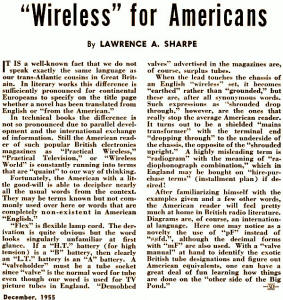|
Author Lawrence Sharpe
pointed in 1955 in this Radio & Television News article the potential
for confusion when reading columns and advertisements written by our brothers from
Across the Pond when they appeared in American electronics magazines. Most of us
are familiar with valve vs vacuum tube, bonnet vs. hood (car), football vs. soccer,
fag vs. cigarette, holiday vs. vacation, nappy vs. diaper, petrol vs. gasoline,
torch vs. flashlight, flat vs. apartment. There are many more, but those come to
mind. Read through this short list of purely electronics terms and learn that "earthed"
is the same as our "grounded." One thing that surprised me was how the Brits had
already adopted pico (e.g. pF) for the numerical unit of 10-12 while
we were still using micromicro (10-6 x 10-6 = 10-12,
e.g., μμF). Note how I
omitted a comma
after "e.g." in the pico parenthetical but included it for micromicro. That is because
the Brits usually omit the comma after "e.g." and "i.e." but Americans include it.
"Wireless" for Americans
 By
Lawrence A. Sharpe By
Lawrence A. Sharpe
It is a well-known fact that we do not speak exactly the same language as our
trans-Atlantic cousins in Great Britain. In literary works this difference is sufficiently
pronounced for continental Europeans to specify on the title page whether a novel
has been translated from English or "from the American."
In technical books the difference is not so pronounced due to parallel development
and the international exchange of information. Still the American reader of such
popular British electronics magazines as "Practical Wireless," "Practical Television,"
or "Wireless World" is constantly running into terms that are "quaint" to our way
of thinking.
Fortunately, the American with a little goodwill is able to decipher nearly all
the usual words from the context. They may be terms known but not commonly used
over here or words that are completely non-existent in American "English. "
"Flex" is flexible lamp cord. The derivation is quite obvious but the word looks
singularly unfamiliar at first glance. If a "H.T." battery (for high tension) is
a "B" battery, then clearly an "L.T." battery is an "A" battery. A "valveholder"
must be a tube socket since "valve" is the normal word for tube even though our
word is used for TV picture tubes in England. "Demobbed valves" advertised in the
magazines are, of course, surplus tubes.
When the lead touches the chassis of an English "wireless" set, it becomes "earthed"
rather than "grounded," but these are, after all synonymous words. Such expressions
as "shrouded drop through," however, are the ones that really stop the average American
reader. It turns out to be a shielded "mains transformer" with the terminal end
"dropping through" to the underside of the chassis, the opposite of the "shrouded
upright." A highly misleading term is "radiogram" with the meaning of "radiophonograph
combination," which in England may be bought on "hire-purchase terms" (installment
plan) if desired!
After familiarizing himself with the examples given and a few other words, the
American reader will feel pretty much at home in British radio literature, Diagrams
are, of course, an international language. Here one may notice as a novelty the
use of "pF" instead of "μμfd.", although the decimal forms with "mF" are also
used. With a "valve manual" at hand to identify the exotic British tube designations
and figure out American equivalents, one can have a great deal of fun learning how
things are done on the "other side of the Big Pond."
Posted August 27, 2020
|










